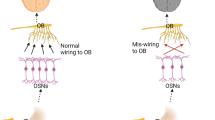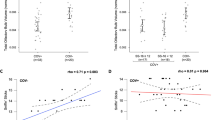Abstract
Patients with anosmia exhibit structural and functional brain abnormalities. The present study explored changes in brain white matter (WM) in non-neurodegenerative anosmia using diffusion-tensor-based network analysis. Twenty patients with anosmia and sixteen healthy controls were recruited in the cross-sectional, case–control study. Participants underwent olfactory tests (orthonasal and retronasal), neuropsychological assessment (cognitive function and depressive symptoms) and diffusion tensor imaging measurement. Tract-Based Spatial Statistics, graph theoretical analysis and Network-Based Statistics were used to explore the white matter. There was no significant difference in fractional anisotropy (FA) between patients and controls. In global network topological properties comparisons, patients exhibited higher γ and λ levels than controls, and both groups satisfied the criteria of small-world (σ > 1). In local network topological properties, patients had reduced betweenness, degree and efficiency (global and local), as well as increased shortest path length and cluster coefficient in olfactory-related brain areas (anterior cingulum, lenticular nucleus, putamen, hippocampus, amygdala, caudate nucleus, orbito-frontal gyrus). Olfactory threshold scores and the retronasal score were negatively correlated with γ and λ, and the retronasal score was positively correlated with FA values in certain WM tracts, i.e. middle cerebellar peduncle, right inferior cerebellar peduncle, left inferior cerebellar peduncle, right cerebral peduncle, left cerebral peduncle, left cingulum (cingulate gyrus), right cingulum (hippocampus), superior fronto-occipital fasciculus, and, left tapetum. Patients with anosmia demonstrated relevant WM network dysfunction though their structural integrity remained intact. Their retronasal olfaction deficits revealed to be more strongly associated with WM alterations compared with orthonasal olfactory scores.


Similar content being viewed by others
References
Beck AT, Steer RA, Carbin MG (1988) Psychometric properties of the beck depression inventory: twenty-five years of evaluation. Clin Psychol Rev 8:77–100
Bitter T, Bruderle J, Gudziol H, Burmeister HP, Gaser C, Guntinas-Lichius O (2010a) Gray and white matter reduction in hyposmic subjects—a voxel-based morphometry study. Brain Res 1347:42–47
Bitter T, Gudziol H, Burmeister HP, Mentzel HJ, Guntinas-Lichius O, Gaser C (2010b) Anosmia leads to a loss of gray matter in cortical brain areas. Chem Senses 35:407–415
Bonanno L, Marino S, De Salvo S, Ciurleo R, Costa A, Bruschetta D et al (2017) Role of diffusion tensor imaging in the diagnosis and management of post-traumatic anosmia. Brain Inj 31:1964–1968
Chen B, Zhong X, Mai N, Peng Q, Wu Z, Ouyang C et al (2018) Cognitive impairment and structural abnormalities in late life depression with olfactory identification impairment: an alzheimer's disease-like pattern. Int J Neuropsychopharmacol 21:640–648
Cross DJ, Anzai Y, Petrie EC, Martin N, Richards TL, Maravilla KR et al (2013) Loss of olfactory tract integrity affects cortical metabolism in the brain and olfactory regions in aging and mild cognitive impairment. J Nucl Med 54:1278–1284
Cui Z, Zhong S, Xu P, He Y, Gong G (2013) PANDA: a pipeline toolbox for analyzing brain diffusion images. Front Hum Neurosci 7:42
Fjaeldstad A, Fernandes HM, Van Hartevelt TJ, Gleesborg C, Moller A, Ovesen T et al (2017) Brain fingerprints of olfaction: a novel structural method for assessing olfactory cortical networks in health and disease. Sci Rep 7:42534
Gellrich J, Han P, Manesse C, Betz A, Junghanns A, Raue C et al (2018) Brain volume changes in hyposmic patients before and after olfactory training. Laryngoscope 128:1531–1536
Gong G, He Y, Concha L, Lebel C, Gross DW, Evans AC et al (2009) Mapping anatomical connectivity patterns of human cerebral cortex using in vivo diffusion tensor imaging tractography. Cereb Cortex 19:524–536
Gullmar D, Seeliger T, Gudziol H, Teichgraber U, Reichenbach JR, Guntinas-Lichius O et al (2017) Improvement of olfactory function after sinus surgery correlates with white matter properties measured by diffusion tensor imaging. Neuroscience 360:190–196
Haehner A, Schopf V, Loureiro A, Linn J, Reichmann H, Hummel T et al (2018) Substantia nigra fractional anisotropy changes confirm the PD at-risk status of patients with idiopathic smell loss. Parkinsonism Relat Disord 50:113–116
Han P, Whitcroft KL, Fischer J, Gerber J, Cuevas M, Andrews P et al (2017) Olfactory brain gray matter volume reduction in patients with chronic rhinosinusitis. Int Forum Allergy Rhinol 7:551–556
Han P, Winkler N, Hummel C, Hahner A, Gerber J, Hummel T (2018) Alterations of brain gray matter density and olfactory bulb volume in patients with olfactory loss after traumatic brain injury. J Neurotrauma 35:2632–2640
Han P, Zang Y, Akshita Y, Hummel T (2019) Magnetic resonance imaging of human olfactory dysfunction. Brain Topogr
Heilmann S, Strehle G, Rosenheim K, Damm M, Hummel T (2002) Clinical assessment of retronasal olfactory function. Arch Otolaryngol Head Neck Surg 128:414–418
Hummel T, Kobal G, Gudziol H, Mackay-Sim A (2007) Normative data for the "Sniffin' Sticks" including tests of odor identification, odor discrimination, and olfactory thresholds: an upgrade based on a group of more than 3,000 subjects. Eur Arch Otorhinolaryngol 264:237–243
Karstensen HG, Vestergaard M, Baare W, Skimminge A, Djurhuus B, Ellefsen B et al (2018) Congenital olfactory impairment is linked to cortical changes in prefrontal and limbic brain regions. Brain Imaging Behav 12:1569–1582
Kobal G, Hummel T, Sekinger B, Barz S, Roscher S, Wolf S (1996) "Sniffin' sticks": screening of olfactory performance. Rhinology 34:222
Koirala N, Anwar AR, Ciolac D, Glaser M, Pintea B, Deuschl G et al (2019) Alterations in white matter network and microstructural integrity differentiate Parkinson's disease patients and healthy subjects. Front Aging Neurosci 11:191
Nasreddine ZS, Phillips NA, Bedirian V, Charbonneau S, Whitehead V, Collin I et al (2005) The Montreal Cognitive Assessment, MoCA: a brief screening tool for mild cognitive impairment. J Am Geriatr Soc 53:695–699
Newman ME (2002) Assortative mixing in networks. Phys Rev Lett 89:208701
Nir TM, Jahanshad N, Toga AW, Bernstein MA, Jack CJ, Weiner MW et al (2015) Connectivity network measures predict volumetric atrophy in mild cognitive impairment. Neurobiol Aging 36(Suppl 1):S113–S120
Oishi K, Zilles K, Amunts K, Faria A, Jiang H, Li X et al (2008) Human brain white matter atlas: identification and assignment of common anatomical structures in superficial white matter. Neuroimage 43:447–457
Oleszkiewicz A, Park D, Resler K, Draf J, Schulze A, Zang Y et al (2019) Quality of life in patients with olfactory loss is better predicted by flavor identification than by orthonasal olfactory function. Chem Senses 44:371–377
Roberts RO, Christianson TJ, Kremers WK, Mielke MM, Machulda MM, Vassilaki M et al (2016) Association between olfactory dysfunction and amnestic mild cognitive impairment and Alzheimer disease dementia. JAMA Neurol 73:93–101
Rottstadt F, Han P, Weidner K, Schellong J, Wolff-Stephan S, Strauss T et al (2018) Reduced olfactory bulb volume in depression—a structural moderator analysis. Hum Brain Mapp 39:2573–2582
Segura B, Baggio HC, Solana E, Palacios EM, Vendrell P, Bargallo N et al (2013) Neuroanatomical correlates of olfactory loss in normal aged subjects. Behav Brain Res 246:148–153
Shah C, Liu J, Lv P, Sun H, Xiao Y, Liu J et al (2018) Age related changes in topological properties of brain functional network and structural connectivity. Front Neurosci 12:318
Small DM, Gerber JC, Mak YE, Hummel T (2005) Differential neural responses evoked by orthonasal versus retronasal odorant perception in humans. Neuron 47:593–605
Smith SM (2002) Fast robust automated brain extraction. Hum Brain Mapp 17:143–155
Smith SM, Jenkinson M, Woolrich MW, Beckmann CF, Behrens TE, Johansen-Berg H et al (2004) Advances in functional and structural MR image analysis and implementation as FSL. Neuroimage 23(Suppl 1):S208–S219
Smith SM, Jenkinson M, Johansen-Berg H, Rueckert D, Nichols TE, Mackay CE et al (2006) Tract-based spatial statistics: voxelwise analysis of multi-subject diffusion data. Neuroimage 31:1487–1505
Sreenivasan K, Zhuang X, Banks SJ, Mishra V, Yang Z, Deshpande G et al (2017) Olfactory network differences in master sommeliers: connectivity analysis using granger causality and graph theoretical approach. Brain Connect 7:123–136
Tzourio-Mazoyer N, Landeau B, Papathanassiou D, Crivello F, Etard O, Delcroix N et al (2002) Automated anatomical labeling of activations in SPM using a macroscopic anatomical parcellation of the MNI MRI single-subject brain. NeuroImage 15:273–289
Wang J, Wang X, Xia M, Liao X, Evans A, He Y (2015) GRETNA: a graph theoretical network analysis toolbox for imaging connectomics. Front Hum Neurosci 9:386
Wattendorf E, Welge-Lussen A, Fiedler K, Bilecen D, Wolfensberger M, Fuhr P et al (2009) Olfactory impairment predicts brain atrophy in Parkinson's disease. J Neurosci 29:15410–15413
Watts DJ, Strogatz SH (1998) Collective dynamics of 'small-world' networks. Nature 393:440–442
Woodward MR, Dwyer MG, Bergsland N, Hagemeier J, Zivadinov R, Benedict RH et al (2017) Olfactory identification deficit predicts white matter tract impairment in Alzheimer's disease. Psychiatry Res Neuroimaging 266:90–95
Wu C, Huang L, Tan H, Wang Y, Zheng H, Kong L et al (2016) Diffusion tensor imaging and MR spectroscopy of microstructural alterations and metabolite concentration changes in the auditory neural pathway of pediatric congenital sensorineural hearing loss patients. Brain Res 1639:228–234
Yao L, Pinto JM, Yi X, Li L, Peng P, Wei Y (2014) Gray matter volume reduction of olfactory cortices in patients with idiopathic olfactory loss. Chem Senses 39:755–760
Yao L, Yi X, Pinto JM, Yuan X, Guo Y, Liu Y et al (2018) Olfactory cortex and Olfactory bulb volume alterations in patients with post-infectious Olfactory loss. Brain Imaging Behav 12:1355–1362
Zalesky A, Fornito A, Bullmore ET (2010) Network-based statistic: identifying differences in brain networks. Neuroimage 53:1197–1207
Funding
This research was supported by a Grant from the Deutsche Forschungsgemeinschaft to TH (DFG HU411/18-1).
Author information
Authors and Affiliations
Contributions
Dr. BCH: conception and design, analysis and interpretation of data; drafted the article; gave final approval of the version to be published. Dr. JA: acquisition of data, revised the manuscript critically for important intellectual content, gave final approval of the version to be published. Dr. PH: revised the manuscript critically for important intellectual content, gave final approval of the version to be published important intellectual content. Dr. DT: Revised the manuscript critically for important intellectual content, gave final approval of the version to be published important intellectual content. Dr. HHK: conception and design, acquisition of data, interpretation of data; revised the. Pro. TH: conception and design, acquisition of data, analysis and interpretation of data; revised the manuscript critically for important intellectual content; gave final approval of the version to be published.
Corresponding author
Ethics declarations
Conflict of interest
The authors declare that they have no conflict of interest.
Additional information
Handling Editor: Christoph M. Michel.
Publisher's Note
Springer Nature remains neutral with regard to jurisdictional claims in published maps and institutional affiliations.
Rights and permissions
About this article
Cite this article
Chen, B., Akshita, J., Han, P. et al. Aberrancies of Brain Network Structures in Patients with Anosmia. Brain Topogr 33, 403–411 (2020). https://doi.org/10.1007/s10548-020-00769-2
Received:
Accepted:
Published:
Issue Date:
DOI: https://doi.org/10.1007/s10548-020-00769-2




